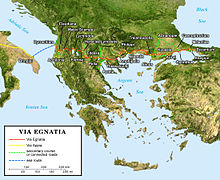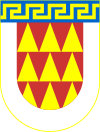Heraclea Lyncestis
Хераклеја Линкестис / Ἡράκλεια Λυγκηστίς / Ἡράκλεια Λύγκου | |
 The Byzantine "small basilica" at Heraclea Lyncestis | |
| Alternative name | Herakleia Lynkestis |
|---|---|
| Location | Bitola, Pelagonia Statistical Region, North Macedonia |
| Region | Lynkestis |
| Coordinates | 41°00′39″N 21°20′33″E / 41.01083°N 21.34250°E |
| Type | Settlement |
| History | |
| Builder | Philip II of Macedon |
| Founded | Middle of the 4th century BC |
| Periods | Hellenistic to Byzantine |
| Cultures | Ancient Greek, Roman |
Heraclea Lyncestis, also transliterated Herakleia Lynkestis (
Foundation by Philip II

It was founded by Philip II of Macedon in the middle of the 4th century BC. The city was named in honor of the mythological hero Heracles. The name Lynkestis originates from the name of the ancient kingdom, conquered by Philip, where the city was built.
Heraclea was a strategically important town in
and town walls.Roman period

The Roman emperor
Late Antiquity and Byzantine periods
In the early
Mosaics in the basilicas


The so-called Small Basilica was discovered in excavations made before the outbreak of World War II between 1936 and 1938. At first it was thought to be an ancient palace, but in the later research from 1960 to 1964, it became clear that it was an early Christian basilica. There is a decorated floor mosaic laid in the technique of "opus sectile" within the basilica and several rooms have been unearthed. The first room was used for baptizing, and the second room has a floor mosaic made in "opus tessellatum" technique. After the creation of the complex Great Basilica, the function of these rooms was changed. By discovering the walls, architectonic plastic and floors were reconstructed electronically.

The Great Basilica is a monumental building with a room of open porch colonnades, a room of
The Great Basilica's mosaic floor is depicted on the reverse of the Macedonian 5000 denars banknote, issued in 1996.[9]
The Episcopacy Residence was excavated between 1970 and 1975. The western part was discovered first and the southern side is near the town wall. The luxury rooms are located in the eastern part. The 2nd, 3rd and 4th rooms all have mosaic floors. Between the 3rd and 4th rooms there is a hole that led to the eastern entrance of the residence. The hole was purposefully created between the 4th and 6th century.
See also
Notes
- ^ The name for the site in the modern Macedonian language, not to be confused with the Ancient Macedonian language.
- ^ Fergus Millar, "Rome, the Greek World, and the East: Volume 1: The Roman Republic and the Augustan Revolution", The University of North Carolina Press, 2001, p. 225: "...the king took him as confidant and sent him as an ambassador to Pompey, encamped at Heraclea Lyncestis in northern Greece."
- ^ Michael Avi Yonab, Israel Shatzman (1976), Illustrated Encyclopaedia of the Classical World, Jerusalem: The Jerusalem Publishing House Ltd. SNB 562 000372 Page 230
- ^ H. B. Walters (editor), (1916), A Classical Dictionary of Greek and Roman Antiquities, Biography, Geography and Mythology pp 480-481
- Hammond, NGL, (1972), A History of Macedonia, Volume I: Historical geography and prehistory, Oxford:At the Clarendon Press, Oxford University Press, p. 59
- ^ a b Morton, Jacob Nathan (2017). "Shifting Landscapes, Policies, And Morals: A Topographically Driven Analysis Of The Roman Wars In Greece From 200 Bc To 168 Bc". Publicly Accessible Penn Dissertations. 2484. University of Pennsylvania: 91.
- ^ Macedonia,
Bradt Guides, Thammy Evans, Bradt Travel Guides, 2007, ISBN 1841621862, p. 182.
- ^ Echos Du Monde Classique, Classical Association of Canada, 1988, p. 368.
- ^ National Bank of the Republic of Macedonia. Macedonian currency. Banknotes in circulation: 5000 Denars Archived 2009-04-27 at the Wayback Machine. – Retrieved on 30 March 2009.


